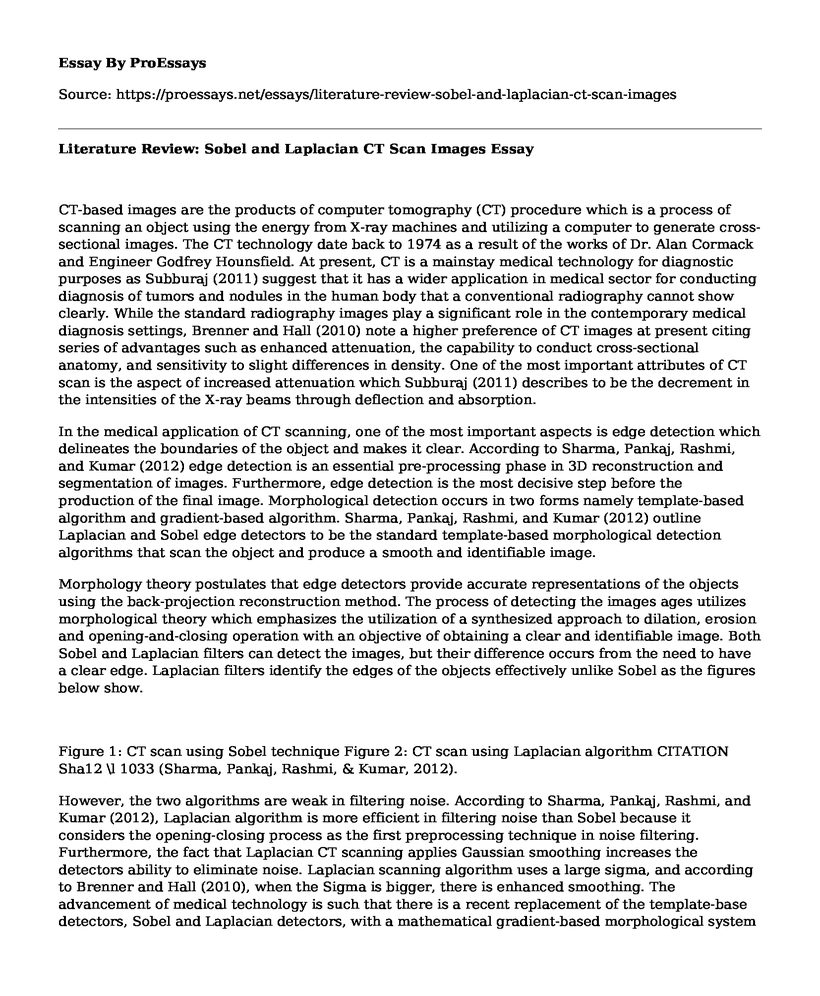CT-based images are the products of computer tomography (CT) procedure which is a process of scanning an object using the energy from X-ray machines and utilizing a computer to generate cross-sectional images. The CT technology date back to 1974 as a result of the works of Dr. Alan Cormack and Engineer Godfrey Hounsfield. At present, CT is a mainstay medical technology for diagnostic purposes as Subburaj (2011) suggest that it has a wider application in medical sector for conducting diagnosis of tumors and nodules in the human body that a conventional radiography cannot show clearly. While the standard radiography images play a significant role in the contemporary medical diagnosis settings, Brenner and Hall (2010) note a higher preference of CT images at present citing series of advantages such as enhanced attenuation, the capability to conduct cross-sectional anatomy, and sensitivity to slight differences in density. One of the most important attributes of CT scan is the aspect of increased attenuation which Subburaj (2011) describes to be the decrement in the intensities of the X-ray beams through deflection and absorption.
In the medical application of CT scanning, one of the most important aspects is edge detection which delineates the boundaries of the object and makes it clear. According to Sharma, Pankaj, Rashmi, and Kumar (2012) edge detection is an essential pre-processing phase in 3D reconstruction and segmentation of images. Furthermore, edge detection is the most decisive step before the production of the final image. Morphological detection occurs in two forms namely template-based algorithm and gradient-based algorithm. Sharma, Pankaj, Rashmi, and Kumar (2012) outline Laplacian and Sobel edge detectors to be the standard template-based morphological detection algorithms that scan the object and produce a smooth and identifiable image.
Morphology theory postulates that edge detectors provide accurate representations of the objects using the back-projection reconstruction method. The process of detecting the images ages utilizes morphological theory which emphasizes the utilization of a synthesized approach to dilation, erosion and opening-and-closing operation with an objective of obtaining a clear and identifiable image. Both Sobel and Laplacian filters can detect the images, but their difference occurs from the need to have a clear edge. Laplacian filters identify the edges of the objects effectively unlike Sobel as the figures below show.
Figure 1: CT scan using Sobel technique Figure 2: CT scan using Laplacian algorithm CITATION Sha12 \l 1033 (Sharma, Pankaj, Rashmi, & Kumar, 2012).
However, the two algorithms are weak in filtering noise. According to Sharma, Pankaj, Rashmi, and Kumar (2012), Laplacian algorithm is more efficient in filtering noise than Sobel because it considers the opening-closing process as the first preprocessing technique in noise filtering. Furthermore, the fact that Laplacian CT scanning applies Gaussian smoothing increases the detectors ability to eliminate noise. Laplacian scanning algorithm uses a large sigma, and according to Brenner and Hall (2010), when the Sigma is bigger, there is enhanced smoothing. The advancement of medical technology is such that there is a recent replacement of the template-base detectors, Sobel and Laplacian detectors, with a mathematical gradient-based morphological system detection which research confirms to be useful in detecting the edges of lungs during the CT medical imaging CITATION Sha12 \l 1033 (Sharma, Pankaj, Rashmi, & Kumar, 2012). When CT process uses an appropriate edge detector and filter, edge detector there is 95% probability of obtaining a CT image that resembles the real object CITATION Sub11 \l 1033 (Subburaj, 2011). It is for that reason that the contemporary medical CT uses gradient-based morphological filters.
References
Brenner, D. J., & Hall, E. J. (2010). Computed Tomography: An Increasing Source of Radiation Exposure. A New England Journal of Medicine, 359(1): 2274-2284.
Sharma, A., Pankaj, S., Rashmi, & Kumar, H. (2012). Edge Detection of Medical Images Using Morphological Algorithms. International Journal of Science and Emerging Technologies with Latest Trends 4(1): 1-6 (2012, 4(1): 1-6.
Subburaj, K. (2011). CT Scanning: Techniques and Applications. San Francisco: Department of Radiology and Biomedical Imaging University of California.
Cite this page
Literature Review: Sobel and Laplacian CT Scan Images. (2021, Jun 28). Retrieved from https://proessays.net/essays/literature-review-sobel-and-laplacian-ct-scan-images
If you are the original author of this essay and no longer wish to have it published on the ProEssays website, please click below to request its removal:
- Analysis of Nursing-sensitive and Quality Indicators that Require Improvement
- Nursing Knowledge Synthesis: From Natural, Social Sciences to Culturally Competent Care - Essay Sample
- Essay Sample on Emergency Management: Saving Lives & Limiting Disaster Costs
- Essay Example on Abortion: A Wrong Act Except in Certain Instances
- Paper Example on Dental Assistants: Essential Members of the Dental Care Team
- Essay Example on Embracing Cultural Diversity in Nursing: Exploring Transcultural Nursing
- Cardiovascular Pharmacotherapy: Impact on Patients and Diabetes Management - Paper Sample







